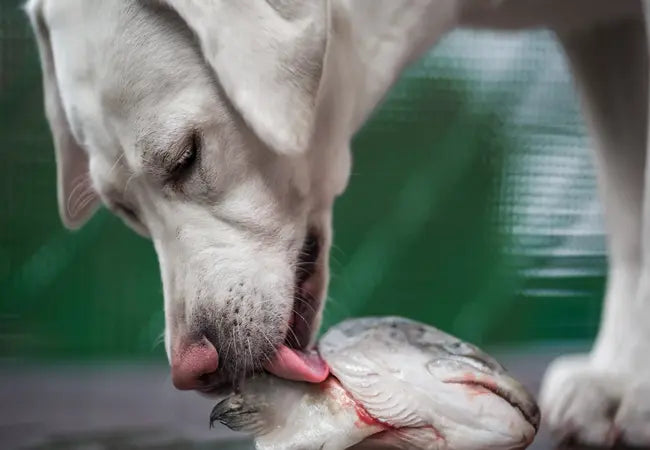Vet’s 2025 Guide to Salmon Poisoning Disease in Dogs Causes, Diagnosis & Treatment🩺

In this article
Vet’s 2025 Guide to Salmon Poisoning Disease in Dogs: Causes, Diagnosis & Treatment🩺
By Dr. Duncan Houston BVSc
💡 What Is Salmon Poisoning Disease?
Salmon poisoning disease (SPD) is a severe systemic illness in dogs caused by the bacterium Neorickettsia helminthoeca, transmitted when dogs consume raw or undercooked salmon, trout, steelhead, or Pacific giant salamanders infected with the fluke Nanophyetus salmincola. The fluke itself is harmless, but it carries the rickettsia that infects dogs, clogging their lymphatic and intestinal systems.
🌍 Geographic Range
SPD is found almost exclusively in the Pacific Northwest—including northern California, Oregon, Washington, southern Vancouver Island—and inland river systems where salmonids live. Dogs eating raw fish in these areas are at risk, especially if ingestion occurs within ~10 days of showing signs.
🧠 Life Cycle: How Dogs Become Infected
- Host 1: Fluke eggs hatch to miracidia in water, infect snails (e.g., Juga plicifera).
- Host 2: Cercaria penetrate salmonid fish or salamanders → encyst as metacercariae in tissues.
- Host 3: Dogs ingest raw fish/salamanders → flukes release bacteria into the bloodstream via the intestine.
🕒 Incubation & Onset
Symptoms typically appear 5–7 days after ingestion—but may take up to 33 days.
🚩 Clinical Signs & Symptoms
- High fever (104–107 °F/40–42 °C), followed by hypothermia in later stages.
- Complete anorexia, severe vomiting (by day 4–5), and bloody diarrhea (day 5–7).
- Enlarged lymph nodes (cervical and mesenteric), eye/nasal discharge, weight loss, weakness.
- Advanced cases may include tremors, seizures, dehydration, and shock.
- Without treatment, mortality reaches ~90% within 7–10 days of symptom onset.
🔍 Diagnosis in 2025
- History & geography: raw fish exposure in endemic areas.
- Fecal exam: fluke eggs detected in ~90% of cases.
- Bloodwork: CBC shows lymphocytosis, possible anemia, thrombocytopenia; chemistry for hydration/organs.
- Lymph node aspirate: intralesional rickettsial organisms detected via cytology.
- PCR or serology: confirm Neorickettsia helminthoeca infection.
🩺 Treatment Protocols (2025)
1. Antibiotics: Doxycycline
Drug of choice: **10 mg/kg twice daily for at least 7 days**, often administered longer based on clinical response. Dogs usually show improvement within 48 hours.
2. Deworming: Praziquantel
Administer after starting antibiotics to kill adult flukes and prevent further transmission.
3. Supportive Care
- IV/subQ fluids to correct dehydration, electrolytes, and acid–base balance.
- Antiemetics, gastrointestinal protectants, and nutritional support if the appetite is poor.
- Blood transfusions for severe anemia or low platelets.
4. Hospitalization
Critical for moderate-to-severe cases involving sepsis, shock, or significant organ dysfunction. In-patient care allows close monitoring, intensive fluids, medications, and diagnostics.
📈 Prognosis & Recovery
- Easily treatable with early intervention and supportive care, most dogs fully recover.
- Delayed treatment carries high fatality (~90% untreated).
- Recovered dogs usually develop strong immunity to N. helminthoeca, though not to related species such as N. elokominica.
- Fluke infection risk remains if exposure continues; avoid raw fish ingestion.
🚫 Preventive Measures
- Avoid all raw or undercooked salmonid fish and salamanders in endemic areas.
- Supervise dogs on streams and clean up fish carcasses to prevent scavenging.
- Properly dispose of fish guts and restrict access near fishing sites/trash cans.
- Educate owners about SPD in affected areas—local vets and wildlife agencies frequently issue reminders.
🏡 Ask A Vet Home‑Support Integration
- 📸 Log symptoms: vomiting, diarrhea, appetite, lethargy, lymph node enlargement.
- 🕒 Set medication, deworming, and recheck reminders (7 and 14 days post episode).
- 📊 Monitor vitals: temperature, hydration, stool consistency; alerts for worsening conditions.
- 📚 Provide tutorials: preventing fish access, safe fishing tips, home care routines.
- 🔔 Receive bins for emergent signs—persistent fever, bloody diarrhea, weakness, or seizures.
🔑 Key Takeaways
- SPD is a tick-free, fluke-borne rickettsial disease unique to the Pacific Northwest.
- Early symptoms mimic other diseases—fever, vomiting, diarrhea, enlarged lymph nodes.
- Diagnosis via fecal fluke eggs, lymph cytology, and PCR confirms infection.
- Treatment: doxycycline + praziquantel + intensive supportive care → survival if promptly treated.
- Prevention: steer clear of raw fish; Ask A Vet app enhances owner vigilance and care compliance.
🩺 Final Thoughts ❤️
In 2025, awareness and prevention are the best defense against SPD. With rapid veterinary treatment and robust at-home support via the Ask A Vet app—like tracking symptoms, reminders, and remote monitoring—dogs exposed to salmon or trout in endemic areas can recover fully. Prepared owners and connected care truly save lives! 🐾✨
Visit AskAVet.com and download the Ask A Vet app to log your dog’s symptoms, medication schedules, photos, and recovery progress—right from your phone. 📲






